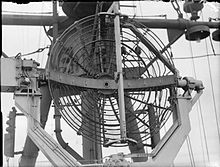 Type 277 antenna on HMS Swiftsure | |
| Country of origin | UK |
|---|---|
| Introduced | 1943 |
| Type | Sea-surface search, early warning |
| Frequency | 2950 ±50 MHz (S-band) |
| PRF | 500 Hz |
| Beamwidth | 6.2º |
| Pulsewidth | 1.8 or 0.7 μs |
| RPM | 0 to 16 rpm |
| Range | 1 to 11 NM (1.9–20.4 km) |
| Diameter | 4.5 ft (1.4 m) |
| Azimuth | 360º |
| Precision | ~2º, 250 yards range |
| Power | 500 kW |
| Other Names | Type 276, 293 |
| Related | Type 271/2/3, 294/5, 980 to 984, CD No.1 Mk. VI, AMES Type 50 to 56 |
The Type 277 was a surface search and secondary aircraft early warning radar used by the Royal Navy and allies during World War II and the post-war era. It was a major update of the earlier Type 271 radar, offering much more power, better signal processing, new displays, and new antennas with greatly improved performance and much simpler mounting requirements. It allowed a radar with performance formerly found only on cruisers and battleships to be fitted even to the smallest corvettes. It began to replace the 271 in 1943 and was widespread by the end of the year.
The Type 271 was one of the first microwave frequency radars to enter service, when microwave electronics design was in its infancy. While it was still being fitted to escort ships during 1941 and 1942, great strides in technique were being made in cavity magnetron, waveguide, antenna design and general electronics. Those upgrades that could be easily combined with the existing systems became the 271 Mark IV models, while those that required longer to develop were originally known as the Mark V. Given the magnitude of the changes, in March 1943 the Mark Vs were renamed as the 277 series.
The 277 used a 500 kW magnetron, compared to the 271's 5 kW, added a much higher gain antenna that was stabilized in pitch, replaced the coaxial cable signal feeds with waveguide, and added a plan-position indicator (PPI) system with several remote displays. While the 271 offered performance to about 3 miles (4.8 km) against a U-boat and had to communicate with the commanders by voice tube, the 277 was limited only by the radar horizon and its display could be read directly on the bridge on larger ships.
The 277 spawned several modified versions, including Type 276 for destroyers and Type 293 for dedicated air warning. These were so powerful that they were adapted for other roles by the British Army for coast watching and artillery spotting, and the Royal Air Force as Chain Home Extra Low to counter German aircraft attacking at very low altitude. Improvements to the electronics continued, leading to the P and Q models which arrived in 1945. Q models remained in service well into the 1950s.
© MMXXIII Rich X Search. We shall prevail. All rights reserved. Rich X Search
